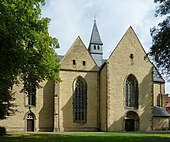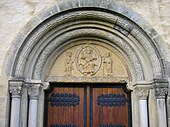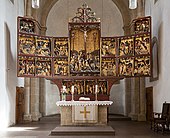Pen Enger
The Enger Abbey in Enger in the Herford district in North Rhine-Westphalia was founded in 947 by Queen Mathilde . It was consecrated initially to Maria and Laurentius , and later to Dionysius . It is considered the burial place of Duke Widukind . In 1414 the monastery was moved to Herford . There the church of St. Johannis in the Neustadt became a collegiate church. The church in Enger became the parish church of the Evangelical Lutheran parish of Enger during the Reformation .
history
After Queen Mathilde withdrew to her inherited possessions after the death of Heinrich I , she founded a collegiate foundation for secular canons in Enger in 947 . King Otto I endowed it with considerable property and granted him free choice of provost and immunity. In 968, after Mathilde's death, the monastery was subordinated to the newly founded Archdiocese of Magdeburg , although it was on the territory of the Diocese of Osnabrück . With that it lost its original independence. Otto also furnished the pen with relics of St. Dionysius of Paris . The date of the translation of the relics is unknown. Otto I's donations for the canons' monastery in Enger began, according to the documents received, in 947 and extended over 950 and 966 to 968. It is noticeable that the pen must initially have had a different patronage than the one known today. Obviously, St. Dionysius originally not worshiped in Enger. The patronage is referred to in the document D. 91 in 947 as "Mariae sanctique Laurentii martiris". Originally there was therefore a Laurentius patronage in Enger. Such a patronage also existed in Merseburg from 955 onwards.
In 1414 the monastery was relocated to the fortified Herford due to numerous attacks and armed conflicts . The canons took away the most important works of art - including the Codex Wittekindeus - as well as the alleged remains of Widukind.
With the move of the canons, the collegiate church of Enger became a parish church. Church saints became Johannes Baptist and Dionysius in Herford.
From 1530, the Reformation took hold in the monastery. In 1549 only one member was Catholic. This state of affairs was established after 1672. In the 18th century, half of the monastery posts were taken to care for Prussian officials.
On December 1, 1810, the monastery was abolished. The archive with around 500 documents and files was transferred to the Minden government archive in 1822 and from there to the Münster State Archive in 1852 .
Even if nothing is left of the monastery buildings apart from the church, the canons' houses around the church on the so-called church circular have shaped the image of the place up to the present day. The former collegiate church is now an Evangelical Lutheran. Parish church.
Composition of the Convention
The conventuals were usually of bourgeois origin and came primarily from Herford and the surrounding area. With the change in the function as supply points for civil servants, the catchment area expanded considerably. We encounter provost, dean, custos and Thesaurius , Scholasticus and Cellerarius as offices . Since the High Middle Ages there have been 12 canons (four priests, four deacons and four sub-deacons). Since the late Middle Ages, five vicars and four beneficiaries have been added. Nothing in this division changed until 1810.
architecture
The church in Enger goes back in part to the 9th century. Archaeological investigations showed that various church buildings had already existed at this point. According to tradition, Duke Widukind is said to have built the first church. Since the first archaeologically verifiable church dates from around 800, this is at least not excluded. This first church was a hall building with a rectangular choir.
The current church was built in different phases between the 12th and 14th centuries. The excavation manager of the excavations in the collegiate church, Uwe Lobbedey , described the construction phases from the 8th century on as buildings I – V. The transept and choir of Building IV are Romanesque ; a two-bay Gothic hall longhouse (Building V) was added to them in the last construction phase in the middle of the 14th century . In the choir of building I, three symmetrically arranged graves could be located (so-called “donor graves”). One each in the northeast (grave 447) and southeastern corner (grave 462) and one in the middle of the choir. They are clearly older than building II, but cannot be older than the oldest church, because apart from their clear location, small bits of mortar at the bottom of the grave filling suggest that the graves were created later within building I. Whether the central “donor grave” is that of the dux Widukind is a matter of considerable dispute in the literature.
As is not unusual for a medieval monastery or collegiate church, the Engeran sacred building did not have a tower. This was only added after the Middle Ages, free-standing, next to the former canons' church, which had become the parish church.
Furnishing
Widukindepitaph
In the church there is, among other things, an epitaph from the year 1100, which is one of the oldest grave sculptures in Germany and, according to tradition, designates the grave site of Duke Widukind. It is a Romanesque image of a reclining person with a crown and scepter. The substructure is from the early renaissance .
Despite extensive research on Widukind's person, it is unclear whether he was buried in Enger at all or whether he did not spend his last years on the island of Reichenau and was buried there. During the archaeological excavations in the 1970s, three graves of related male dead from the time of origin in the choir of the original church, which have been interpreted as belonging to the donor family. This means that the probability that Widukind was buried in Enger has increased again a little. This is contradicted by the fact that the oldest documents of the monastery from the 10th century do not mention the grave. The first written references come from the year 1216. At that time it was believed to have found the bones during an excavation.
The tomb prompted the SS to plan the construction of a “national” memorial and pilgrimage site here from 1934. The outbreak of the Second World War prevented the realization.
Further interior fittings
In addition to the epitaph, some Gothic furnishings such as crosses, altarpieces and the like remained in Enger after the canons left or were added later. The carved altar by Hinrik Stavoer dates from 1525 after the canons left. A baptismal font dates from 1677. On the east wall of the north transept there is a dark relief stone with the black face showing the facial features of St. Mauritius shows. It symbolized the former affiliation of the Enger canons to Magdeburg, where the saint was patron.
Dionysian treasure
The greatest treasures that were formerly in the possession of the monastery and are now partly in the Kunstgewerbemuseum Berlin are traditionally referred to as the Dionysius Treasure . This included a Romanesque lecture cross made of wood covered with gold. There is also a Romanesque aquamanile , a bird-shaped jug with a crowned human body. Noteworthy is a pocket-shaped reliquary from the 8th century with a core made of wood (so-called Engerer Burse ). The front side is covered with sheet gold and adorned with precious stones and gems . The other sides are made of gold-plated silver sheet and are decorated with chased bust portraits in two-row arcades. There are also other reliquaries and other liturgical implements.
Codex Wittekindeus
The so-called Codex Wittekindeus , which is now in the State Library in Berlin , also belonged to the monastery . According to tradition, it was one of Charlemagne's christening gifts to Widukind. In fact, however, it dates from the time of Otto the Great and was initially owned by the Magdeburg Cathedral . The codex was created in Fulda and bound in Magdeburg. The codex was based closely on a manuscript from the time of Charlemagne and is considered to be one of the most important works of Ottonian book illumination. It was given to the Great Elector in the 17th century as a tribute from Herford, who had become Brandenburg in 1647, and has since been kept in the Berlin State Library (Theol. Latin fol. 1).
organ
The organ was built in 1974 by the organ building company Gustav Steinmann (Vlotho). The instrument has 34 stops on three manuals and a pedal .
|
|
|
|
||||||||||||||||||||||||||||||||||||||||||||||||||||||||||||||||||||||||||||||||||||||||||||||||||||||||||||||||||||||||||
- Coupling : I / II, III / II, I / P, II / P, III / P
Bells
In the tower of the collegiate church there are three large bronze bells - the Wigbert bell, the hero bell and the Wittekinds bell.
Toast
- Adelger 950
- Siegfried before 1094
- Ulrich 1121
- Otto 1171
- Heinrich (longus) 1194 – approx. 1202
- Siegfried von Ampfurth 1202–1208
- Wilbrand von Dassel 1249-1250
- Volkwin von Schwalenberg 1252–1262
- Günther I. von Schwalenberg 1268–1305 / 09
- Gebhard von Schraplau 1310
- Volrad of Hesse 1343–1344
- Heinrich von Wederden 1366
- Johann von Ockenbrock? –1371
- Bernhard of Ostinchusen 1418
- Hartlieb Conekamp 1422/1423
- Richard Richarding (or Richardi) 1435/1449
- Heinrich Keserling 1462/1471
- Konrad Thus before 1489
- Hermann Ovelsuster 1489–1508
- Bernhard Dörinck 1508/1525
- Ludolf von Varendorff 1545/1568
Individual evidence
- ↑ Wentz, Gottfried / Schwineköper, Berent: The Archdiocese of Magdeburg. Volume 1. Part 1: The St. Moritz Cathedral Monastery in Magdeburg. Part 2: The collegiate monasteries St. Sebastian, St. Nicolai, St. Peter and Paul and St. Gangolf in Magdeburg. Berlin 1972, p. 231 Partial digitization
- ↑ Krüger, Karl Heinrich, Dionysius and Vitus as early Hottonic king saints. To Widukind 1, 33, in: Frühmittelalterliche Studien 8 (1974), p. 142 u. 149.
- ↑ Gabriele Böhm: Medieval figural tombs in Westphalia from the beginnings to 1400 Berlin-Hamburg-Münster, 1993 pp. 33–35.
- ↑ Contribution to Widukind, History and Myth.
- ^ Page no longer available , search in web archives: Insignia of power: Art and written culture of the Romanesque
- ↑ cf. Article on the renovation of the tower
- ↑ Wentz, Gottfried / Schwineköper, Berent: The Archdiocese of Magdeburg. Volume 1. Part 1: The St. Moritz Cathedral Monastery in Magdeburg. Part 2: The collegiate monasteries St. Sebastian, St. Nicolai, St. Peter and Paul and St. Gangolf in Magdeburg. Berlin, 1972 p. 438 Partially digitized
- ↑ Hengst, monastery book p. 293.
literature
- Carl Wilhelm Clasen: Enger - The former collegiate church St. Dionysii ( large architectural monuments , issue 167). Munich / Berlin 1961
- Karl Hengst (Ed.): Westphalian monastery book. Lexicon of the monasteries and monasteries established before 1815 from their foundation to their abolition. Part 1, Münster 1992, pp. 288-294.
- Uwe Lobbedey: Preliminary report on the excavation in the Stiftskirche zu Enger , in: The excavations in the Stiftskirche zu Enger I (Preservation of monuments and research in Westphalia 1), Münster 1979, pp. 9-18.
- A. Ludorff: The architectural and art monuments of the Herford district. Munster, 1908.
- The Church of Enger and its relationship with Wittekind. Bielefeld 1902 ( ULB Münster )
- Fred Kaspar / Peter Barthold: Parish tower and collegiate church - shared building loads and common tasks. The tower next to the collegiate church Enger (Kr. Herford). In: Mareike Liedmann and Verena Smit (eds.): Access to archeology, building research and art history - not only in Westphalia (= Festschrift for Uwe Lobbedey on his 80th birthday), Regensburg 2017, pp. 177–194.
Web links
Coordinates: 52 ° 8 ′ 22.5 ″ N , 8 ° 33 ′ 31.4 ″ E











